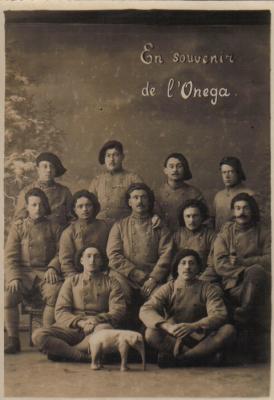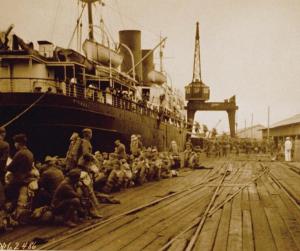Bonsoir à tous,
En faisant le relevé du monument aux morts de ma commune favorite (Fillinges - 74) et en comparant avec MDH, j'ai trouvé un cas tres intéressant que je soumets à votre sagacité.
Il s'agit du Sous Lieutenant Narcisse Bourgon, disparu le 18 mars 1919, à Bolche Ozerki (Russie du Nord).
Notre sous-lieutenant a deux fiche MDH :
Une au 21e Btn Colonial de Marche
http://www.memoiredeshommes.sga.defense ... 442035335
et l'autre au 21e RIC
http://www.memoiredeshommes.sga.defense ... -784859771
Je lis également que la petite garnison française du village de Bolshie Ozerki a été détruite par les troupes bolchévique le 17 mars (à la date du 23 mars
http://pages.prodigy.net/mvgrobbel/phot ... ements.htm )
Si vous avez plus d'information sur ce personnage, ou s'il vous permet de rassembler un peu plus les pièces du puzzle, merci de nous le faire savoir.
Bien cordialement
Adrien
Hello Adrien,
Please excuse my use of English, but here is a little more information from Chapter 6 of the book "Russian Sideshow" about the events of March 17, 1919 at Bolshie Ozerki:
On March 16th, Captain Ballensinger relocated Company H [US Army 339th Infantry Regiment] Headquarters from Onega to Chekuevo in order to keep in close touch with the Railroad Force at Obozerskaya. To do this, Ballensinger sent regular patrols from Chekuevo east to Bolshie Ozerki, only sixteen miles from the railroad headquarters at Obozarskaya. This little village would be the site of the final battle of the North Russian Campaign [for the American troops].
[British] General Ironside had no firm knowledge of a plan by Siberian Allied Forces to link with the North Russian [Allied] Forces; however, the Soviets feared that Kolchak forces under Czech General Gaida were moving toward Viatka on the Trans-Siberian Railroad for a possible linkup with the North Russian Allies. While this was far-fetched in hindsight, it was a possible reason for a Bolo offensive in Bolshie Ozerki.
While a diversionary assault took place by the Soviets against Vistafka on the Vaga River, the offensive which Ironside had feared started when the Bolos moved in force out of Plesetskaya, moving between Onega and the Vologda Railroad, headed for Bolshie Ozerki. Some twelve hundred Reds on skis moved silently toward the few French who were on outpost duty there, taking them by surprise on March 17, 1919. The French were quickly and quietly wiped out; the Bolos had driven a wedge between the Onega Force and the Railroad Force in Obozerskaya. With the Reds in Bolshie Ozerki unopposed, Soviet General Kuzmin could then move on Obozerskaya and cut off the units below, then move straight on to Archangel. It was the most vulnerable position for the Allies during the North Russian campaign.
The Onega Force in Chekuevo had no knowledge that the Soviets had captured Bolshie Ozerki when they sent a routine patrol east toward the village, a two day trek. The six-man patrol disappeared; after they failed to report back, searchers were sent out.
The ill-fated American patrol arrived at Bolshie Ozerki just after the Reds occupied the town. One of those subsequently captured, Pvt. Earl Fulcher, reported that he had joined the French detachment in the village as the Bolsheviks attacked on March 16th, then fought with the Allied group of French, Russians and Americans who were surrendered by the French commander. [According to Pvt. Fulcher,] "The engagement continued all day Tuesday [March 18th], and until about Wednesday afternoon, when the enemy artillery reached our position, and the French officer in command went out with a white flag and surrendered the entire detachment, consisting of about 50 French, Americans and Russians."
Sincerely,
Mike Grobbel
http://pbma.grobbel.org
